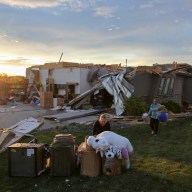Next week scientists are heading back down to the Titanic and they’re taking some extreme technology with them.
They’ll create a three-dimensional map of the wreck and assess the ship’s rate of deterioration.
The deterioration is “very controversial,” said local Titanic expert Steve Blasco, who is a scientist based at the Bedford Institute of Oceanography (BIO).
“Some say the rate of corrosion and the rate of which the ship is falling apart means within a couple of decades it could collapse. Others say it’s protected by corrosion and it will still be here in 100 years or so,” he said.
Scientists will use high-definition imagery and a remote vehicle to gather data. It should help with determining how fast the wreck is deteriorating.
“We were on the wreck in 1991 and there was a change between 1991 and 1985. The rust rivers had expanded and rusticles seemed to be growing. Even within that time frame we could see changes on the wreck.”
Scientists from Woods Hole Oceanographic Institute in Massachusetts and the RMS Titanic Inc., which owns the rights to the wreck, will leave from Newfoundland on Aug. 18 for a 20-day expedition.
It’s the first expedition to the site since 2004.
Even if the Titanic is wasting away, there’s not much that can be done about it — not without a lot of money.
“It will corrode and collapse,” Blasco said. “If that actually happens, we are missing an opportunity to make observations.”
There are no Canadian scientists on this mission but BIO will be interested in the results.
“We use the Titanic as a time marker and we’ll probably be consulting with Woods Hole scientists to take a look at the imagery to see if we can learn something about the geological and biological environment.”
History
The Titanic hit ice on its maiden voyage on April 15, 1912.
• Death toll 1,522 people were killed.
• Disaster The bow and stern separated during sinking and lie about a half a kilometre apart.
• Discovery Robert Ballard discovered the wreck site in 1985.
• Dollars The cost of this expedition is in the millions of dollars.
















